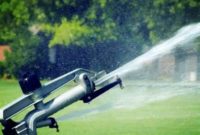Like many gardeners, we began watering our plots with overhead sprinklers. To compensate for the occasional lapse of memory, we set up automatic sprinkler timers. The cheap mechanical water timers often failed so we upgraded to the electronic sprinkler timers, which to this day have been the most reliable. We’re on well water and our well has always yielded the best water with great pressue. But when sprinkling, the pressure would often vary with the timing and usage of water elsewhere. Coverage could be spotty. To “spot water” new plantings, containers, and seedbeds, we also used watering wands.
For our small garden patch, we used a lot of water and not very efficiently. We would come out after a good wetting and mush over the soggy paths to our dripping crops to find an assortment of slugs, mosquitoes, and various fungi and molds encroaching on our garden Eden.
Finally, last year we set our pulse sprinklers and fan sprinklers aside and laid in a system of soaker hoses. We went with these because they were cheaper and seemed far more simple than the drip systems. Also, we’d decided to change over to primarily straw bale gardening and many straw bale garden mavens were pleased to use soakers as well. We got two soaker hose kits and were happy with how easy they were to install.
One thing about kits (and this seems to apply to all kinds of kits), is it seems there’s always one or more missing parts. For the soaker hose layout, we needed more connections (T’s and L’s), wire pins to anchor the hoses, extra end caps, and hose connectors.

The kit makers likely know this and sell the “extra” pieces at a premium. It’s about as cheap to order another kit than to buy piecemeal, in terms of cost and time in scouting out all that you’ll need.
We shopped our local hardware store and found barbed 1/2″ Pex plumbing fittings that were slightly oversized. These were ground down a bit with a Dremel, and secured into the hoses with small radiator hose clamps. For end plugs, we cut sticks into wood “corks” and secured them with the hose clamps.
Given a modest set-up time and tinkering with the connections, the soaker hose system is a huge win over the the sprinkler method. The soaker hose system is a huge win over the sprinkler method.
We know there are many that prefer the overhead systems–not having to work around embedded hoses and such, but we very much prefer going local with our water. The hoses put the water right at the base of the plants, and the leaves above stay relatively dry which means less slug damage and moisture related diseases. The pressure surges and resultant uneven coverage are non-issues. The paths between the rows are much less soggy. It’s so easy to regulate the timing and quantity. Moreover, we use far less water.
Disadvantages of Soaker Hose Irrigation
As much as we like the soaker hose method, there are some drawbacks:
1. The porous hose material is susceptible to sun damage and eventually develops leaks that shoot fine spurts of water in every direction.
2. Compared to a drip irrigation system, the soakers are more like a scatter-shot than a point source, where it’s hard to gauge how much water they are releasing.
3. It’s a challenge to incorporate soakers into containers without running intermediate garden hose lines.
Drip systems allow the best possible spot irrigation.
